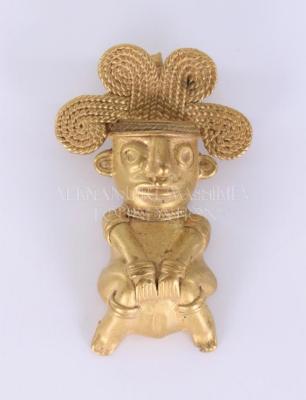Pendant
Jewellery
Inventory number
2022.3.1.4.JW.NC.C1970.MXDescription
Matte gold brass pendant representing a woman in the pre-Hispanic style, kneeling and wearing a large headdress. She is represented naked wearing bracelets on the forearms, wrists and below the knees as well as a ring in the nose.This pre-Columbian style pendant certainly belongs to the Tayronas culture, an important Amerindian group that occupied the territory of the current department of Magdalena in Colombia, in the Región Caribe.
Gradually from the end of the WW2, the Cold War took hold. It opposes two camps with a radically different vision, one carrying the communist ideology, the other capitalist. At the same time, in Latin America, Ernesto GUEVARA (1928-1967), then a young medical student, travels through Latin America, which puts him in direct contact with the poverty in which a large part of the population lives. He is close to the Guatemalan revolution (1954), then to Fidel Castro in Cuba (1953-59). He theorizes the Cuban revolution which he tries to export (unsuccessfully) to the Congo then Bolivia where he finally finds death in 1967. After denouncing the exploitation of the Third World by the two Cold War blocs, the character of "Che" quickly meets an international popular idolatry, like the success of the song "Hasta siempre, Comandante" written in 1965 by Carlos Puebla. This idolatry also carries with it panhispanism, the whole meeting a certain interest among young people, especially through hippie ideologies. Amerindian art then met with some success through Mexican export jewelry based on a pre-Columbian style.
Material
BrassOrigin
circa 1970 MexicoDimensions
Width : 2 cmLength : 3.5 cm
Height : 5 cm
Related objects
Pair of earringsPair of earrings
Pair of earrings
